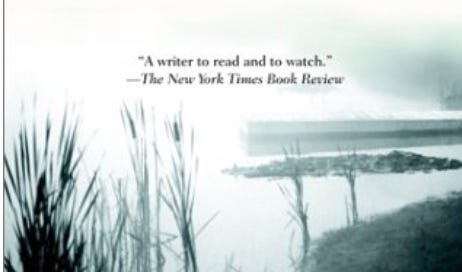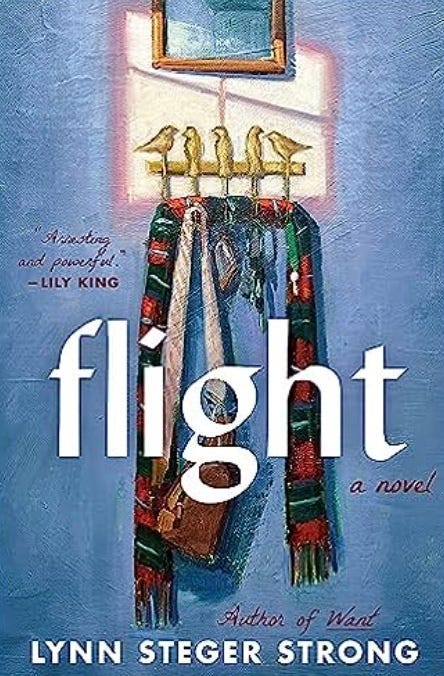BookLife Dual Review: Crow Lake by Mary Lawson, and Flight: A Novel by Lynn Steger Strong
adult siblings, memory, coming of age, growth, trauma, loss of parents, grief, natural world, parenthood, child-raising, Canada, upstate New York
Crow Lake and Flight: A Novel were published 21 years apart. Both admirably unravel the dynamics of adult siblings, the impact of place and the power of family secrets.
Mary Lawson’s Crow Lake was published in 2002, but it remains powerfully relevant today as we move in a world where nuclear families do not remaing eographically proximate to one another, but are separated not only by miles but by the hurts and wounds and experiences that childhood can deliver. Experiences are often understood and remembered differently by siblings in a single household.
Kate grows up in Northern Ontario, Canada, in a tiny farming community with only a handful of families as residents. There is a local general store, a church and a school. She is the third of four siblings, with two markedly older brothers and a young sister. When the story begins, Kate is 7, her brothers, Luke and Matt, are 19 and 17 and her baby sister Bo is 1 and a half. Tragedy strikes the siblings when their parents are killed in an automobile accident. Family and neighbors intervene but the eldest brother rejects the plan to separate the siblings. He declines a university scholarship to become a teacher and decides to raise his two young sisters together with his brother. The second brother is the true scholar of the family but circumstances upend his trajectory toward university. Ultimately it is Kate who reaches university and becomes the zoologist and
researcher she always believed her beloved intellectual brother Matt was meant to become.
Pace and patience are Lawson’s greatest talents. She is unhurried and as an author meticulously creates an environment that swaddles the family in the geography of the ponds and forests of their town. Kate and Matt spend countless hours studying the life and plants at the nearby pond, learning about the natural world as they grow. Told in part in flashback, with present and early past hurtling through time toward the novel’s ultimate climax, Lawson does not rush. She unfurls the story slowly. She probes the trauma and the builds the healing, and she allows Kate to arrive at her own painful epiphany with enough of life remaining for her to recover. As the novel draws to a close, the reader is struck by the power of trauma to influence perception and even memory. Clearly, the trauma experienced by the siblings was shared, but so too was it also deeply personal and individual. Lawson’s writing is exquisite and leaves the reader in search of more of her books.
Flight: A Novel by Lynn Steger Strong traverses similar ground. Henry, Martin and Kate are adult siblings convening at the home of Henry and his wife, Alice, to celebrate their first Christmas since their mother’s death. Each of the siblings, and their spouses, bring their own emotional baggage and wounds along for the journey. Henry and Alice are childless, not by choice, but by too many failed pregnancies to bear. Both were working
artists but after Alice inherits a house from her grandmother, the couple leave New York City and move to the woods of upstate New York. Alice leaves behind her art and falls back on her social work degree. She becomes somewhat perilously overly involved in the lives of one young mother and daughter. Martin is a college professor under investigation for an improper conversation with one student about another, and his wife Tess is a power lawyer in New York. Their eldest suffers from untreated ADHD and the couple battles over the best approach to his condition. Kate, the youngest sibling, is married to Josh and is mother of three, a daughter and younger twin boys. She enjoys motherhood and models herself over her own mom, the loss of who she grieves deeply. Josh was once the beneficiary of generational wealth but a series of risky poor investments has rendered him dependent on his somewhat meager salary. Kate is eager to take over their mother’s Florida house and move there with her family, but her siblings and their spouses resist that idea.
The circumstances and tensions stew and build in the days leading into Christmas, with their deceased mother’s traditions and the somewhat precarious employment circumstances of all three couples weighing heavily on the assembly of six adults and five children in a almost too-cozy home in upstate New York. Many of the siblings’ and couples’ circumstances are not known to the group at large. Over the course of the novel, meals and cocktails and conversations are shared and tensions rise. Each sibling, and perhaps more significantly each of their spouses have strong opinions about the spouses, marriages, career choices and parenting styles of each of the other siblings. Strong’s ability to parse this complex matrix of relationships reveals her social-emotional intelligence as an author. She is able to weave sufficient detail into each interaction (a cigarette sneaked outside, a fastidiousness about food preparation, a reaction to matching outfits for the annual Christmas photo, an inability to step away from work emails) to lay bare the complexity of adult siblings convening in the face of a shared loss. They are no longer just siblings. They are husbands and wives and mothers and fathers and lawyers and social workers and artists. They have likes and dislikes, financial challenges, and eccentricities that have become layered amour each wears as they have aged. The layers of their lives complicate their ability to interact with their siblings in the past, simpler way they all remember. Their shared grief over their loss of their mother draws them together, but the new shapes of their lives and their now-disparate interests make the fit of their reunion deeply challenging.
Both novels probe the journey from childhood to adulthood, the role of memory, the impact of traumas, both early and later ones, and the obstacles that arise in siblings’ efforts to relate to one another authentically as adults and to make room for the adults those siblings have become. The novels highlightthe maturity and grace that is necessary for adult siblings to allow each other the space to make choices that each may have made differently than other siblings. It is a journey known by anyone with siblings, or even cousins in lieu of siblings. It is the coming-of-age we experience in mid to late life, wholly different in its emotional arc than the one we experience as we move from childhood to young adulthood.





